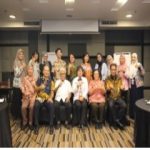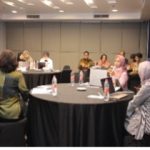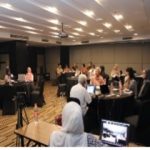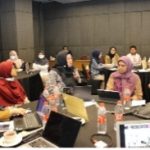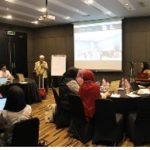Estimated reading time: 14 minutes
Dr. Ir. Sudarto, MM.IMV Centre for Optimisation of Industrial Technology Utilisation and Industrial Services Policy, Ministry of Industry ____ Rozy A Jafar Nutrition International
In studying the salt situation in Indonesia, several things must be considered, including the amount of national salt demand, Universal Salt Iodisation (USI) targets, iodised consumption salt production, the magnitude of the difference in estimated production and consumption needs by province and district. Actions to increase the production and distribution of salt and iodised salt must be accompanied by technological development.
Implementation of the USI-IDD Programme
Political commitment to the elimination of IDD is currently low, as evidenced by the USI not being achieved. Within the MoH, this is partly due to the misrepresentation of the Basic Health Research 2013 results which gave the impression that IDD was no longer a problem and that a portion of the population had excess iodine intake. As long as the Ministry of Health does not prioritise IDD elimination and salt iodisation, it is unlikely that other sectors will.
While the coordination committee for the IDD programme exists on paper, it has ceased to function and little national government coordination, oversight or implementation guidance has been provided in recent years. Meanwhile, a very complex, potentially dysfunctional, structure exists for the management and coordination of the salt industry. National efforts to develop the salt industry have not taken salt iodisation into account and there is little recognition of the implications of developments in the salt industry on the salt iodisation programme.
BPOM pada dasarnya adalah satu-satunya lembaga pemerintah yang melakukan pemantauan peraturan untuk yodisasi garam. Namun, ini terjadi di tingkat ritel dan tidak mewakili total pasokan garam. Tampaknya tidak berkontribusi pada peningkatan kepatuhan terhadap standar nasional, yang terhambat, setidaknya di antara produsen skala kecil dan menengah, oleh kesulitan dalam memenuhi syarat untuk sertifikasi SNI dan lisensi kesehatan. Sementara Kemenkeu, melalui LSPro melakukan pemeriksaan dan pemantauan di tingkat produksi, pemantauan ini terutama lebih ditujukan untuk perizinan daripada penegakan hukum.
WHO telah menargetkan target Universal Salt Iodization (USI) sebesar 90% masyarakat di setiap Kabupaten/Kota mengonsumsi garam yodium sesuai SNI dengan kandungan KIO3 antara 30-80 ppm. Namun data Riskesdas 2013 menunjukkan sekitar 77,1% penduduk mengonsumsi garam beryodium sesuai standar, dan sekitar 8,1% mengonsumsi garam tak beryodium. Hasil pemetaan menunjukkan cakupan kebutuhan konsumsi garam beryodium sekitar 13% mengalami kekurangan terutama di Provinsi produsen garam yaitu Jawa Barat, Jawa Tengah, Jawa Timur, Bali, Nusa Tenggara Barat, Nusa tenggara Timur, Sulawesi Selatan dan Sulawesi Tengah. Untuk itu, diperlukan sistem monitoring berkala yang berkelanjutan dan saling terintegrasi agar target Universal Salt Iodization yaitu sebesar 90% masyarakat di masing-masing Provinsi, Kabupaten/Kota mengonsumsi garam yang memenuhi syarat SNI dapat tercapai.
The shortage of iodised salt consumption in smallholder salt producing centres is around 125 million kg, equivalent to 42 million people who still need iodised salt. This situation is due to the land area used for salt production in Indonesia of around 24 thousand ha with an average production of 71.6 tonnes per ha with a decreasing trend in the amount of potential land for smallholder salt production. So far, around 343 small and medium industries (SMIs) produce iodised salt with details of 89 SMIs in West Java, 108 in Central Java, 43 in East Java, and 47 in South Sulawesi. So far, around 16 large salt industries are actively producing salt.
In line with the lack of political commitment and national coordination and supervision, there has been little advocacy or guidance to local governments on salt iodisation in recent years. While some local governments have been effective in ensuring salt is adequately iodised, others have not taken any action or have implemented ineffective interventions due to poor understanding of the issues and lack of guidance from the national level.
Iodised Salt Coverage and Iodine Nutritional Status
Based on the Basic Health Research 2013, the iodine status of school-age children and women of childbearing age, as well as pregnant women, is adequate at the national level. However, these national data may hide sub-national disparities. In addition, the misrepresentation of the Basic Health Research 2013 urinary iodine data has led to the interpretation that approximately one-third of the Indonesian population has iodine excess. This is not the case. Urinary iodine concentrations from spot urine samples, as collected by Basic Health Research 2013, cannot be used to assess the iodine status of individuals, and hence not the proportion of individuals with iodine deficiency or excess.
Titration data from Basic Health Research 2013 shows that the proportion of Indonesian households consuming adequately iodised salt according to national standards (≥ 30 ppm) decreased from 56.5 per cent to 47.2 percent between 2007 and 2013. RTK data, which should not be used to assess the adequacy of iodisation, shows that iodised salt coverage has increased significantly in some provinces, suggesting that positive results are possible with concerted and well-focused efforts. Titration and RTK data confirm that the proportion of salt without iodine is relatively low.
The iodine status of Indonesian population groups is adequate although only about 50 per cent of households consume adequate iodised salt. This implies that the Indonesian diet contains sources of iodine other than household salt, most likely iodine in drinking water or from the use of iodised salt in processed foods. Most anecdotal data from food processors suggest that a significant proportion of salt used in food processing is iodised. Further analysis of the Basic Health Research 2013 data is planned, which will enable a greater understanding of the relationship between iodised salt coverage and iodine status, the situation of sub-groups, and the level of iodine intake from sources other than household iodised salt.
An increasing proportion of salt is consumed as salt in processed foods, rather than directly as household salt. It is estimated that at least half of this salt is iodised although it is currently considered that it is not mandatory to use iodised salt in food processing and some industries oppose its use.
Salt Industry
Indonesia is self-sufficient in salt for domestic use when the weather is favourable for salt production. Due to recent efforts to increase domestic salt production, considerable excess stocks have been carried over from previous years resulting in a net oversupply of domestic salt. However, domestically produced salt is of lower quality and higher price than imported salt, and controls have been established for salt imports to protect the domestic salt industry. Nevertheless, imports of high-quality salt are allowed for the chemical industry and some imports of high-quality raw salt are also allowed for the food processing industry. To allow for this, salt for food processing was re-categorised from consumption salt to industrial salt in 2014. Domestically cultivated salt is purchased by domestic salt processors for washing, crushing, and anodising. Recent data on the total number of salt processors is not available but the total is estimated to be around 300, 10 of which are large-scale and are estimated to process 65-70 percent of all salt.
Salt producers who are upstream industries are people's salt and those produced by PT Garam; Intermediate industries or salt processors generally produce raw material salt and various industrial salts. Meanwhile, the downstream industry or user industry produces iodised consumption salt and miscellaneous food salt. Only 9 provinces of the 38 provinces in Indonesia, produce salt for domestic consumption needs. The salt production centres are Aceh, West Java, Central Java, East Java, Bali, West Nusa Tenggara, East Nusa Tenggara, South Sulawesi and Central Sulawesi. Thus, 29 provinces are highly dependent on salt production obtained from salt producing provinces.
Basic Health Research 2013 data shows that relatively few households consume non-beryodium salt. Non-beryodium salt is believed to be raw salt that leaks into the market from salt farms because farmers cannot sell it to salt processors. Therefore, the problem of non-beryodium salt is exacerbated when the production of raw salt exceeds the requirements.
Large, medium and small salt processors are all believed to be able to iodise their salt although the capacity of small and medium processors is certainly lower, particularly in relation to adequate internal quality assurance processes. KIO3 is purchased from Kimia Farma or imported directly, especially by larger processors.
Legislation
Several different laws affect the salt iodisation programme either directly or indirectly. Despite the plethora of laws in Indonesia, weaknesses and ambiguities exist in the laws for mandatory salt iodisation, which have hindered the successful implementation of the programme. To date, there are 62 laws and regulations governing the distribution of salt and iodised salt issued by around 13 Ministries/Institutions and Local Governments. Several different laws affect the salt iodisation programme either directly or indirectly. Despite the many laws in Indonesia, weaknesses and ambiguities exist in the laws for mandatory salt iodisation, which have hindered the successful implementation of the programme.
Presidential Decree No 69/1994 on the Procurement of Iodised Salt and subsequent laws set conditions for iodised salt rather than emphasising the iodisation of all salt. This approach may limit the availability of iodised salt as the prescribed conditions for iodised salt production are not achievable by small and medium-scale salt processors. Recent changes in SNI 4435 for "industrial raw materials for iodised salt" will resolve some of these constraints.
Current legislation on the use of iodised salt for food processing is ambiguous although the use of iodised salt for food processing and fish salting is specified in the Presidential Decree of 1994. However it seems that the new RSNI 4 8207: 20xx for salt for the food industry will resolve most of these ambiguities if it is approved as currently drafted (requiring iodisation of salt for food processing), if it applies to all processed foods, including salted/dried fish, and if it is made mandatory. Some other findings related to the legalisation of salt fortification are:
- The current SNI 4435:2000, for "salt as raw material for iodised salt industry" is a loophole to avoid universal salt iodisation. However, the revision addresses the current weakness and will reduce the standard of salt that can be processed for iodised consumption salt. The revised standard recognises the capacity of local salt farmers to produce quality salt and will increase the absorption of raw salt by salt processors.
- SNI 3556:2010 for iodised table salt has not been notified to the World Trade Organisation by the National Bureau of Standards (BSN). This raises the question of whether salt iodisation is mandatory in Indonesia.
- SNI 3556:2010 for iodised table salt, applicable at the production level, and indicates a minimum potassium iodate content of 30 ppm, which is equivalent to 18 ppm iodine. This is lower than what is recommended in the latest guidelines issued by WHO for food-grade salt fortification considering the estimated salt consumption by the Indonesian population. A further concern is that standards have not been set for KIO3/iodine levels in salt at the retail or household level, to account for iodine losses during the distribution chain. If salt processors follow this SNI and only add 30 ppm potassium iodate at the production level, it may be the reason why most salt is found to be insufficiently iodised at the retail/household level in BPOM and RISKESDAS monitoring, as some iodine is lost between production and retail/household.
- About 20 percent of domestic salt production is processed by about 300 small-scale processors. Most of them are unable or unwilling to obtain SNI certification, and therefore MD registration from BPOM. They are also excluded from applying for PIRT registration because they produce mandatory SNI products. This leaves them without any form of product registration beyond a basic business licence and hence they cannot access any support or be monitored.
Regarding Presidential Regulation No. 126 of 2022 on the acceleration of national salt production, the President on 6 October 2020 has given the following directions:
- Improving the Quality of People's Salt, find solutions to improve the quality of people's salt that has not met the standards for industrial needs
- Improvement of people's salt supply chains, make major improvements to people's salt supply chains from upstream to downstream to overcome the low national salt production.
- Availability of production land Accelerate the integration and extensification of smallholder salt land in ten salt producing provinces
- Use of production technology innovations Use production technology innovations, especially washing plants so that post-production can really provide availability, especially in storage warehouses
- Downstream development of the salt industry Prepare the downstream development of the salt industry and develop its derivative industries
Recommendations and Follow-up Plan
- Coordination and management
- The correct presentation of RISKESDAS 2013 results is related to iodine status and RTK results. A corrected presentation would reveal that there is no excess iodine intake and while most salt is iodised, a significant proportion remains insufficiently iodised. The data suggest that implementation of the current salt iodisation programme is unlikely to sustainably ensure adequate iodine intake from the entire population. [MOH]
- Conducted additional analyses of RISKESDAS 2013 data to examine the association between UIC, salt consumption, processed food consumption, and water iodine content. Conduct sub-group analyses on titration and UIC data (if sample size is sufficient) such as by geographic region or province and wealth quintile. In particular, analyse UIC rates for populations consuming salt with varying levels of iodine. [Ministry of Health]
- Based on a corrected understanding of the iodine status of the Indonesian population, advocate for increased government prioritisation and coordination for mandatory salt iodisation. [MOH]
- Re-establish a multi-sectoral coordination structure to oversee the implementation of the GAKY elimination/salt iodisation programme. This structure should be linked to other food fortification programmes (e.g. wheat flour fortification) and salt iodisation should be integrated into broader efforts under SUN to improve community nutrition. Salt iodisation and its enforcement need to be established as a routine activity of the salt industry and government. [MOH and Bappenas]
- Advocate for a better coordination mechanism for the management of the salt industry to address current complexities and weaknesses. The improved coordination mechanism needs to have the authority to coordinate the activities of multiple ministries/agencies and the coordinating ministry. [Ministry of Marine Affairs and Fisheries and Bappenas]
- Similarly, strong linkages need to be developed between the salt iodisation programme and efforts to develop and strengthen the domestic salt industry. Salt iodisation needs to be included in activities to support the domestic salt industry and the implications of changes/developments in the salt industry and national salt supply on the salt iodisation programme need to be understood. [Ministry of Marine Affairs and Fisheries and Bappenas]
- Develop implementation guidelines for IDD salt elimination/iodisation programmes for local governments, recognising that necessary and effective actions will differ in salt producing and salt importing districts. In particular, local governments in salt-producing districts need to develop a sustainable resource system to monitor compliance and enforce the national standard for iodised table salt. [Bappenas, through coordination of salt elimination/iodisation programme]
- Ensure that future surveys do not misrepresent urine iodine data as a reflection of an individual's iodine status and do not use RTK to assess adequacy of iodisation. Future surveys should also assess consumption of processed foods to enable estimation of the contribution of processed foods to iodine intake. [MOH]
- Establish an institution to manage the "Stunting and IDA reduction programme";
- Facilitation of a centralised national budget.
- Regulation/Legalisation
- Harmonise salt policies and standards;
- Make monitoring of salt iodisation regulations more effective. Strengthen monitoring at the production level in the 12 districts where most salt is produced and processed. Develop a regulatory monitoring system for iodised salt along with systems for wheat flour and edible oil fortification as the same principles of the regulatory system should apply to all. [BPOM and MoF]
- Finalise and issue SNI 4435:2015 for Raw Salt for the Iodised Salt Industry as this will facilitate the uptake of raw salt by salt processors for processing and iodisation. [BSN and Ministry of Industry]
- Finalise and publish RSNI 8207:20xx for Salt for Food Processing and make it mandatory, so that all salt for food processing is iodised. Make it clear that it also applies to salt used in salting/drying fish. Once SNI 8207 is published, and made mandatory, update all SNIs for processed foods to specify the use of salt as per SNI 8207. [BSN and Ministry of Industry]
- Finalise and publish RSNI 3556: 2016 and make it mandatory by (i) issuing MOI regulations making it mandatory and (ii) BSN information to the WTO. [BSN and MOI]
- Recognising that salt is not a high-risk product, relax SNI certification and health licensing requirements to allow small-scale salt processors that meet basic food hygiene and iodisation standards to quality for SNI certification and health licensing and/or PIRT registration. This would allow all small-scale salt processors to be fully licensed and monitored, and potentially access support to improve the quality of their products and their compliance with national standards. [BPOM]
- Review the required level of iodine in salt (SNI 3556:2010/2016) taking into account (i) the estimated intake of salt by the Indonesian population, (ii) the current MUIC levels of the national population, different population groups and sub-national populations, and (iii) the fact that a significant proportion of salt is consumed as salt in processed foods and that these will be enriched once SNI 8207 is endorsed, and (iv) the estimated loss of iodine between production and consumption in the Indonesian context. The setting of salt iodine levels should consider the WHO guidelines for food grade salt fortification. [BSN, MOI and MOH]
- Establish adequate iodine levels at retail and household levels for monitoring purposes, taking into account the average iodine losses of different salt qualities, between production and consumption/household. [MOH, MOI and BPOM].
- Evaluation of the USI programme
- Mapping the need for production, distribution, consumption and shortage of iodised salt that meets SNI requirements;
- Conducted additional analyses of RISKESDAS 2013 data to examine the association between UIC, salt consumption, processed food consumption, and water iodine content. Conduct sub-group analyses on titration and UIC data (if sample size is sufficient) such as by geographic region or province and wealth quintile. In particular, analyse UIC rates for populations consuming salt with varying levels of iodine. [Ministry of Health]
- Ensure that future surveys do not misrepresent urine iodine data as a reflection of an individual's iodine status and do not use RTK to assess adequacy of iodisation. Future surveys should also assess consumption of processed foods to enable estimation of the contribution of processed foods to iodine intake. [MOH]
- Develop a production to distribution development programme to increase coverage of iodised salt consumption in deficient areas effectively, efficiently and sustainably in each region;
- Develop an integrated monitoring system for all stakeholders from the centre and regions that is sustainable based on Industry 4.0;
- Support for the salt industry
- Advocate with KKP to support salt farmers to produce higher quality salt rather than larger volumes. This will reduce import demand and increase absorption of domestically produced salt by salt processors. And it will reduce the availability of non-iodised salt at the household level. [Bappenas, and Coordinating Ministry for Maritime Affairs]
- Enhance collaboration between IDD salt phase-out/iodisation programmes and those that support the development of the domestic salt industry so that efforts to increase salt production and quality include iodisation. Such collaboration should also recognise that uncontrolled increases in domestic salt production, beyond national requirements, are likely to increase the availability of non-beryodium salt in households. [Bappenas, and Coordinating Ministry for Maritime Affairs]
- Where necessary, support small and medium scale salt processors to develop their capacity to produce quality iodised salt through investment in higher quality iodisation equipment, training in iodisation techniques and training on appropriate but adequate internal quality assurance systems. Support may also be needed to access KIO3, such as through local agents or in smaller packages. [MPA and MOI]
- Implement intellectual property-based technological innovations in potential production areas and consumption areas
Releated:























